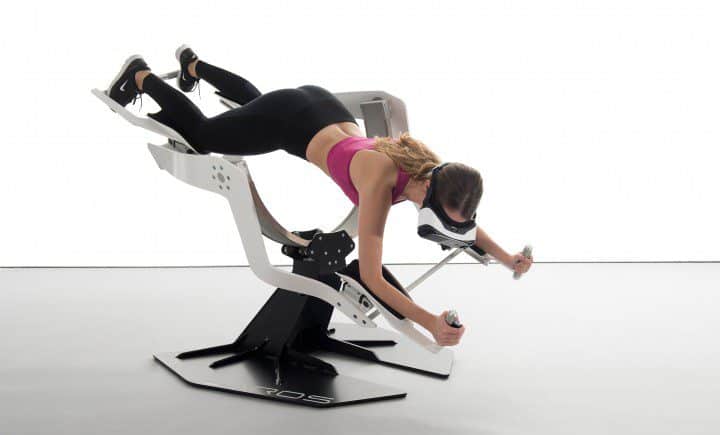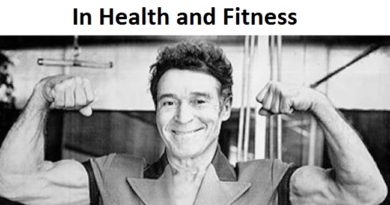Next Generation: Virtual Reality Fitness
Gaming nerds unite! Actually, this isn’t just for gamers. Virtual reality fitness seems to be knocking on our doorstep with new technology coming to the market. The newest craze is the Oculus Rift virtual headset that so many people are raving over. For many this will be super exciting, for others I’m sure they could care less. The biggest markets for VR will be the gaming market as well as (believe it or not) the porn market. So all you guys living in your mom’s basement really won’t have a reason to get off the couch and see natural light or fresh air. Have fun playing your video games all day and dry humping air when you get lonely. Weirdos.
Related Article: Can Interactive Fitness Get You Better Results?
Disclaimer: This article is for informational purposes only and is not meant to treat or diagnose any condition. It is recommended that you speak with your doctor before starting any exercise program.
Virtual Reality Fitness Not Just for Gamers
For those of you who are into fitness (which is probably most of you since you’re reading this article), there’s good news as virtual reality fitness will be coming soon. Hong Kong is currently rolling out this concept in a training studio for spin classes. The studio houses a 270-degree VR screen and is the first of its kind. Exercise enthusiasts come in and attend the class in hopes of not getting bored halfway through. In fact, the concept is blowing up.
Related Article: Virtual Reality Fitness Helps the Elderly
Pure Fitness in Hong Kong and Les Mills are designing the content for the spin class and the details sound really interesting. Some gyms are even using the Oculus Rift virtual headsets mentioned above and allowing the cyclists to ride through remote locations and take their mind off of stationary pedaling. By using the Oculus Rift headset, if you have a stationary bike at home or a road bike with a stand that allows you to pedal without actually moving, you can utilize the VR platform right in the privacy of your own home.
What Does VR Mean for the Fitness Industry?
Well, if you ever took a spin class you’ll know that you’re staring at a mirror, the instructor, or the person’s butt in front of you—not to mention if you’re not used to the class you’ll leave feeling as if you were violated. If you don’t know what I mean, go take a class and by the end when you get off you’ll know exactly what I’m talking about.
Now, with the advent of VR, you can cycle through some of the world’s most exotic locations. They are calling it “Immersive Fitness.” And their goal is to be able to remove yourself from reality and be fully engrossed in animation and music through the VR platform. This gives exercisers a new way of making fitness/cardio fun and not so monotonous.

Some parents are especially thrilled at the idea of getting their children excited about exercise—although to them it would be a “game” and not so much thought of as a workout. Games will have avatars who you will play against to keep things fun and engaging. Many users of the VR platform who have been a part of the spin class mentioned above said after a few minutes you totally forget you are in a game and you feel as if you are truly in that environment. They also mentioned that due to how real it becomes and how your mind/body play tricks on each other, everyone in the class needed to sign a motion sickness disclaimer before the class began.
Other Fitness-Related VR Platforms
Cardio isn’t the only form of exercise the programmers are considering. Another platform they mentioned is yoga. They spoke about how amazing it would be to go through a class that had sun salutations on the summit of Mount Everest. Or doing yoga on a beach at sunset with the sounds of the ocean in the background. The sky is the limit and their imagination is the only thing holding them back.
While there are a lot of great ideas floating around, they don’t come without a very hefty price tag. The costs involved in making a VR “game” are not cheap and if it fails there’s a lot of money that ends up going down the drain. For that reason, designers and programmers are putting in a lot of time deciding what games they want to create and bring to market.
VR Weight Lifting?
While the thought of lifting weights literally anywhere in the world sounds amazing, I highly doubt we will ever see a “virtual weight room”. The thought of moving heavy weights around in la-la-land seems like there would be some liability attached. Each game would probably come with the business card of an attorney in the packaging. It appears that stationary cardio exercise will be the main niche for virtual reality exercise market as well as things like yoga and Pilates.
But let’s dream for a minute here and just throw out a quick wish list. What if a VR game was created that gave you the ability to lift weights while using something such as the Oculus Rift headset? Giving you the ability to travel back in time and be standing inside Gold’s Venice where you are able to train (virtually) with the likes of Arnold, Lou, Franko, and other bodybuilding legends by your side. Or the ability to take you to Texas where you can train with Ronnie Coleman at Metro Flex. While it’s a total longshot, how cool would that be?
How Much Will This Virtual Reality Fitness Cost?
If you are considering VR exercise and are thinking about moving forward and purchasing the headset, you’ll need to shell out some major dough. According to the Oculus Rift website , the headset alone is going to cost you $599 (plus tax and shipping). Due to the high demand you are only allowed to purchase one unit and it won’t ship until the August 2016 timeframe. And don’t forget about the cost of the games that you will need to factor in. While the $599 won’t turn off many people (it’s pretty much in line with other game systems today when they launch), I think it will be the curiosity that will kill the cat (or wallet). People will want to know what VR is all about and what the experience is like. For that reason, I feel Oculus Rift will be a huge success and from there, many other competitors will come out of the woodwork to create their own VR headset or device.
For years everyone has been on the virtual reality bandwagon wondering when something will finally be available that takes people out of our little box we live in and into the world of imagination and 3-D. While the 3-D televisions are cool, VR gaming will take things to the next level. Being interactive puts a new twist on the feeling of simply being in the setting. Now you get to interact with things and objects as if you were literally in that VR space. You can pick items up, throw them, kick them, build with them, etc.
A friend of mine was recently in Vegas for a technology conference. There were several vendors and manufacturers there pushing VR and what the future holds for it. Ultimately from what they were saying, the VR market could easily be a billion-dollar industry in no time at all.
Can Virtual Reality Fitness Help the Elderly?
There has been a ton of hype surrounding virtual reality fitness and how it can help people—there’s a lot of skepticism. The thought of putting on goggles to put yourself into a virtual environment and “working out” just doesn’t seem like it belongs in the same sentence. Most people are used to picking things up, putting them down, and doing some form of cardiovascular activity. However, now researchers are finding that virtual reality fitness may be truly beneficial, at least for the elderly.
Virtual Reality Fitness is on the Rise!
Gamers are loving virtual reality fitness. One thing that does a lot of damage to adults who are getting up in age are falls. Falling as we age can cause many different forms of injuries. These injuries can cause people’s quality of life to suffer. For this reason, researchers gathered around 300 individuals between the age of 60 and 90 who previously suffered a fall to take part in a study—the average age for all participants was 74. In the 6 months prior to the study, the individuals who agreed to help with the study fell on average 11.3 times in that 6-month period. The researchers tallied that 130 of the participants had Parkinson’s disease, 43 had a mild form of cognitive impairment, and 109 had a history of falls without a clear reason why.
Related Article: Can Interactive Fitness Get You Better Results?
For this particular study, the researchers asked the group to walk on a treadmill 3 times a week for a total of 6 weeks. Half of the participants were given virtual reality headsets to use while on the treadmill while the other half received nothing. There was no set speed for the study, rather the researchers instructed the participants to walk at a comfortable pace on the treadmill for 45 minutes per session. The control group merely walked on the treadmill for the given amount of time while the virtual reality fitness group had to move around objects in their way, adjust their gait, and overall navigate around using the treadmill for their 45-minute sessions.
After the study the researchers found that both groups showed improvements in walking speeds and moving around obstacles in their path. However, the virtual reality group did show a more significant improvement overall. They also followed up with the participants to see if any changes took place with the amount of falls they were experiencing over the span of 6 months’ post study participation. What they found was that those who used the virtual reality system fell significantly less than the control group. While the control group did have less falls compared to previously, the change was minor.
The researchers mentioned, “Our idea was to use the virtual reality environment to safely train both the motor or gait aspects that are important to fall risk, while also implicitly teaching the participants to improve the cognitive functions that are important for safe ambulation. The study showed that this type of training is effective in reducing falls and fall risk in a large diverse population. Thus the findings support the use of motor cognitive training to enhance health and reduce fall risk in a growing older population.”
Source:
Mirelman, Anat., et al. “Addition of a Non-immersive Virtual Reality Component to Treadmill Training to Reduce Fall Risk in Older Adults (V-TIME): A Randomised Controlled Trial.” The Lancet. N.p., 11 Aug. 2016.


*Disclosure: This article may contain affiliate links or ads, which means we earn a small commission at no extra cost to you if you make a purchase through these links. These commissions help support the operation and maintenance of our website, allowing us to continue producing free valuable content. Your support is genuinely appreciated, whether you choose to use our links or not. Thank you for being a part of our community and enjoying our content.
PLEASE CONSIDER SHARING THIS ON YOUR SOCIAL MEDIA TO HELP OTHERS LEARN MORE ABOUT THIS TOPIC.





